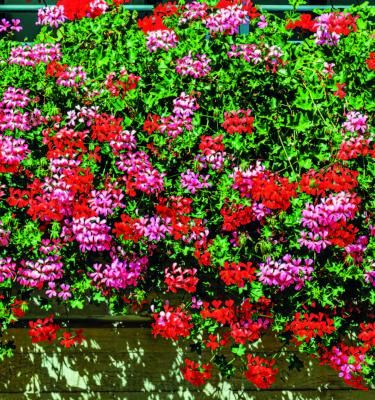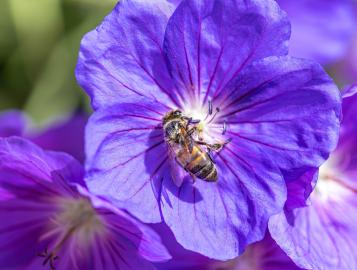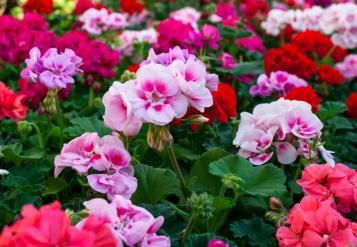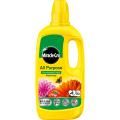

How to grow geraniums
Geraniums are versatile plants which can add a multitude of colours and scents to the garden. Put these popular plants in any part of the garden, whether sunny or shaded, and with sandy or clay soil or anything in between. They are robust and easy to grow and have a lot to offer wildlife too.
Types of geraniums to grow
Geraniaceae is a large family of plants made up of several smaller groupings, or genera. One of these groupings is the genus Geranium. A separate genus is Pelargonium. The two are often muddled as the plants look similar, and the names are commonly used interchangeably. So, what are the differences between geraniums and pelargoniums?
When first discovered and documented, both pelargonium and geranium were lumped together in the same genus. They were later separated into separate genera, but the confusion has persisted.
A useful way to distinguish the two genera of plants is to look at the flowers. Geranium have five petals, which are all very similar to each other. Pelargonium also have five petals, with two of the petals looking similar to each other, and three petals which also look like each other, but are different to the pair.
Pelargoniums are tender plants, hence sometimes being called ‘tender geraniums’. Geraniums are usually grown as perennial plants and are able to withstand frosty conditions, hence sometimes being called ‘hardy geraniums’.
There are over 70 different types of of geranium, and many more cultivars. Some of our favourite cultivars include:
- Geranium cinereum ‘Ballerina’. Pale pink petals with a purple vein and purple centre.
- Geranium maculatum ‘Elizabeth Ann’. Brown foliage and pink flowers.
- Geranium 'Light Dilys’. Pretty light pink petals, with dark pink veins.
- Geranium phaeum ‘Album’. Frilly edged pure white flowers.
- Geranium Rozanne ‘Gerwat’. Light purple petals with dark purple veins and a white centre.
- Geranium Dreamland ‘Bremdream’. Pale pink petals with dark pink veins.
As true geranium are so frequently mixed up with pelargoniums, it’s worth looking out for the word ‘cranesbill’ on the plant label or website listing. This is another catch-all name used to distinguish them from Pelargonium.
There are several types of pelargonium, each with many cultivars to choose from:
- Zonal. These cultivars have a ‘zone’ of red, blue or purple running through the leaf.
- Ivy leaved. With a trailing habit, these are great in hanging baskets and containers.
- Regal. Strongly perfumed stunningly large blooms.
- Angel. Much like the Regal, but with smaller flowers.
- Fancy Leaved. As the name suggests, intricate and multi-coloured foliage.
- Scented Leaf. Beautifully scented foliage, producing heady smells that include rose, pineapple and lemon.
- Unique. Similar to the Scented Leaf Geranium, but with a ‘fuller’ bloom.
- Stellar. Unusual flowers with densely packed petals.
What you’ll need to grow geraniums and pelargoniums

Geraniums and pelargoniums can both be grown from seed sown indoors in winter and early spring. They can also both be bought as plants from websites and most garden centres. This is a good way to find and grow a range of different varieties.
Pelargoniums should be planted out in mid-spring, after the threat of frost has passed. They are best bought as plants. You will need:
- A container or hanging basket.
- Miracle-Gro® Peat Free Premium All Purpose Compost.
- A pelargonium plant and any other summer bedding plants.
To plant a pelargonium you will need to:
- Fill the container or hanging basket with compost.
- Remove the plants from the trays or pot, and arrange in the container, planting them so that the top of the soil is level with the soil in the container.
- Backfill with soil to ensure good contact between the plants and compost.
- Water well and keep well-watered throughout the summer.
In the autumn, remove the pelargonium to the compost heap and replace with winter bedding.
Geraniums can also easily and cheaply be propagated by division. Simply cut an existing plant into two clumps with a sharp spade in the autumn or spring.
To grow a geranium you will need:
- Spade
- All-purpose compost
- A geranium plant (purchased, or a divided clump)
To plant the geranium:
- Use the spade to dig a hole larger than the rootball of the geranium.
- Incorporate Miracle-Gro® Peat Free Premium All Purpose Compost to the loose soil in the hole.
- Remove the plant from the pot and place it in the hole. Ensure that the surface of the ground is level with the top of the rootball of the plant.
- Backfill the hole with soil, firming in to ensure good contact between the plant and the ground.
- Water well, and mulch with Miracle-Gro® Peat Free Premium Fibre Smart™ Mulch.
Geraniums self-seed very often, so also look out for plantlets which can be lifted and relocated.
Where to plant and grow your geraniums and pelargoniums
Geraniums can be grown in full sun, partial shade or full shade. They do not like waterlogged soil, preferring well-drained but moist soil. They are perfect for a border or rockery as they can be planted out and need little attention thereafter. They are perennial plants and provide low ground cover with their densely packed leaves. These will die back in the winter, but the plant will reshoot in the spring.
Pelargoniums have very different growing requirements to geraniums. They must have full sun, and will need to be replaced each year as they are sensitive to frost. They are well suited to containers, hanging baskets and the fronts of flower beds.
<2>Caring and nurturing for your geraniums and pelargoniums

Geraniums and pelargoniums need to be well watered after planting. Both should be deadheaded as blooms die back.
Geraniums often produce a large number of tiny flowers, so a quick way to do this is to take a pair of garden shears to them and roughly trim the plant to no shorter than 5cm (2”) above ground level. This cutting back can be done in winter, early spring, and again mid-summer. Pelargonium flowers should be removed one at a time.
Pelargoniums are not frost-hardy, so will need protection if they are to survive UK winter temperatures. Bring them inside to a greenhouse or conservatory. Most species of geranium do not need protection from winter weather.
Keep geraniums weed free by mulching in the spring. Hand weed any which pop up, but don't be tempted to hoe the soil as this can easily damage the shallow roots.
Common pests and diseases with geraniums and pelargoniums
The Geraniaceae family is affected by many different pests and diseases. These tend to cause problems more for container-grown plants and those over-wintered indoors, so Pelargoniums are particularly vulnerable. Some of the most common in the UK include…
Greenfly
Green or light brown insects which are 1-3mm long. They cluster on fresh growth, sucking the sap and leaving a sticky residue. Squish by hand, encourage beneficial predators such as ladybirds, and if very bad apply a chemical treatment.
Grey mould
Grey mould is caused by a fungus called Botrytis cinerea, the main symptom is furry grey-grown patches on the plant. Prevent with good air flow and dispose of decaying material.
Pelargonium rust
Pelargonium rust is a fungal disease particularly affecting zonal species. The main symptom is rusty brown spotting on the leaves. Avoid by providing good air flow around the plant, and remove any infected plant material.
Whitefly
Whitefly are White aphids, symptoms and treatment are as for greenfly above.
Vine weevil
Vine weevils are a real nuisance to container-grown plants, this pest can nibble the leaves and roots of a plant, weakening and sometimes killing the plant. Avoid by encouraging wildlife predators, and remove any grubs found in the soil. Use a chemical control if needed.
Key features of geraniums and pelargoniums
| Flowering season(s) | Spring, Summer, Autumn, Winter |
|---|---|
| Foliage season(s) | Spring, Summer, Autumn, Winter |
| Sunlight | Partial shade, Full sun |
| Soil type | Chalky, Clay, Loamy, Sandy |
| Soil pH | Neutral |
| Soil moisture | Moist but well-drained |
| Ultimate height | Up to 90cm (3ft) depednding on variety |
| Ultimate spread | Up to 50cm (20in) depednding on variety |
| Time to ultimate height | 9-12 months |




